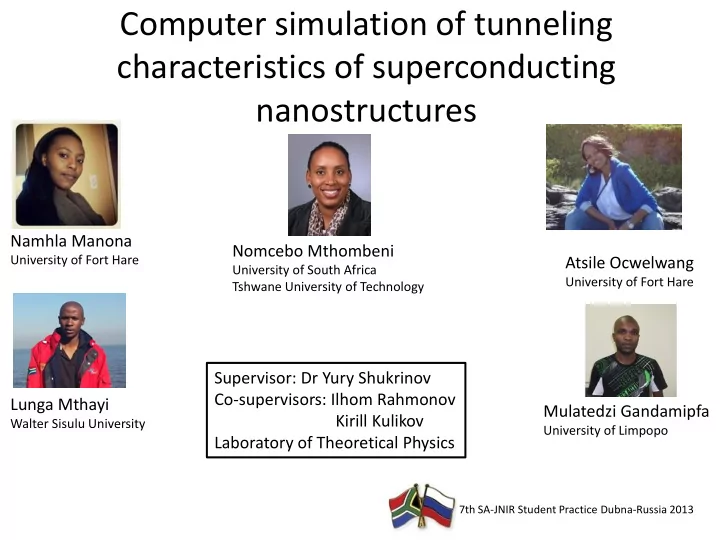

Computer simulation of tunneling characteristics of superconducting nanostructures Namhla Manona Nomcebo Mthombeni University of Fort Hare Atsile Ocwelwang University of South Africa University of Fort Hare Tshwane University of Technology Supervisor: Dr Yury Shukrinov Co-supervisors: Ilhom Rahmonov Lunga Mthayi Mulatedzi Gandamipfa Kirill Kulikov Walter Sisulu University University of Limpopo Laboratory of Theoretical Physics 7th SA-JNIR Student Practice Dubna-Russia 2013
Introduction Models of JJ systems with capacitive coupling CCJJ CCJJ+DC Single JJ
Diagram and equations The current through a system of coupled Josephson junctions The current through the shunt
Equations The frequency of the resonant circuit with the capacitance of Josephson junctions
Objectives
Task 1 Mulatedzi Gandamipfa University of Limpopo Aim : study the effect of system parameters on the properties of Shapiro Steps(SS), when it is on rc -branch
Results : The current-voltage characteristics for a single Josephson junction and for the system of 10 transitions. 6 60 5 50 Without shunting 4 40 V V 3 30 2 20 1 10 0 0 0 0.5 1 0 0.5 1 I I 8 80 With shunting 6 60 V 4 V 40 2 20 0 0 0.5 1 1.5 0.5 1 1.5 I
Results 32.8 32.8 6 32.6 5 32.6 V 80 80 V V 4 32.4 80 32.4 70 3 0.6 0.8 1 1.2 1.4 1.6 I 32.2 70 0.7 0.8 0.9 1 1.1 1.2 I 32.2 0.7 0.8 0.9 1 1.1 1.2 I 60 60 60 V V 50 V 50 40 40 40 30 30 20 20 0.5 1 1.5 0.5 1 1.5 0.5 1 1.5 I I I
Task 2 Atsile Ocwelwang University of Fort Hare Aim : To study the appearance of the rc-branch for small and large values of capacitance
Results Current-Voltage characteristics (CVC) Voltage-time dependence (V(t)/t) L= 0.2 C=1.25 I time 1=0.2 I time 2=0.8 β =0.2 N=1
Results Voltage-time dependence (V(t)/t) Current-Voltage characteristics (CVC) L=45 C=0.002 I time 1=0.2 I time 2=0.8 β =0.2 N=1
Results Low inductance (L=0.2) Large inductance (L=45)
Task 3 Nomcebo Mthombeni University of South Africa Tshwane University of Technology
Results : The effect of resistance on current-voltage characteristic for lower shunt capacitance ......................R=0 N=1 .....................R=0.25 ......................R=0 3.6 ....................R=0.5 .....................R=0.25 6 ...................R=0.75 ....................R=0.5 ...................R=0.75 ....................R=1 3.5 ....................R=1 5 3.4 4 V 3 V 3.3 2 3.2 1 3.1 0.65 0.7 0.75 I 0 0 0.5 1 I .........R=0 N=10 .........R=0 60 .........R=1 .........R=1 .........R=10 .........R=10 50 36 40 V 30 V 34 20 10 0 32 0.6 0.8 1 0.64 0.66 0.68 0.7 0.72 0.74 0.76 0.78 I I
Results: The effect of resistance on current-voltage characteristic for higher shunt capacitance .......R=0 6 ......R = 0 60 ......R=0.5 ......R=1 .....R=1 N=1 ......R=10 5 4 40 3 V V 2 N=10 1 20 0 0 0.5 1 I 0 .......R=0 0.4 0.6 0.8 1 1.2 ......R=0.5 I .....R=1 3.4 3.2 V 3 2.8 0.6 0.65 0.7 0.75 I
Task 4 Lunga Mthayi Walter Sisulu University
Results N = 10 c = 1.25 A = N = 10 c = 1.25 A = 0.5 L = 1.0546875 0.5 L = 1.0546875 omega = 3.2 Amp omega = 3.2 Amp 0.5 0.5 Itime1 = 0.87 Itime2 = 0.8 zoomed v/t Voltage (Currant) = V/I Ch(time) Voltage (time) = V/t
Task 5 Namhla Manona University of Fort Hare
Results: Current-voltage characteristics and time dependence Frame 001 23 Sep 2013 Frame 001 23 Sep 2013 80 34 60 V2 40 32 Itime1= 0.54 Itime2= 0.67 zoomed V2 20 30 0 0.5 1 1.5 V1 28 26 Voltage(current)= V/I 0.6 0.65 0.7 0.75 V1 Voltage(time)=V/t
Conclusion • The purpose of the project was to learn about Systems of high temperatures superconductors Models of these superconductors Methods of how to calculate I-V characteristics, voltage as a function of time and charge as a function of time • Using these methods we obtained results that we presented • However we cannot conclude on these results because it is work in progress
Acknowledgements Supervisor: Dr Yury Shukrinov Co-supervisors: Ilhom Rahmonov Kirill Kulikov Laboratory of Theoretical Physics Practice Coordinators: SA and Russia JINR
Thank You – Spasibo
Recommend
More recommend